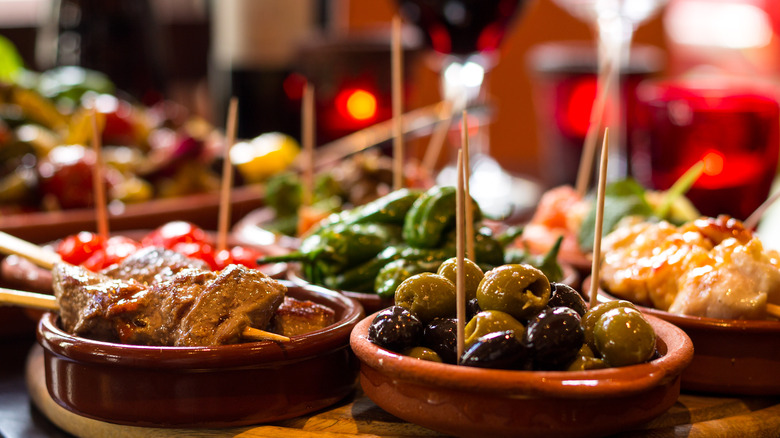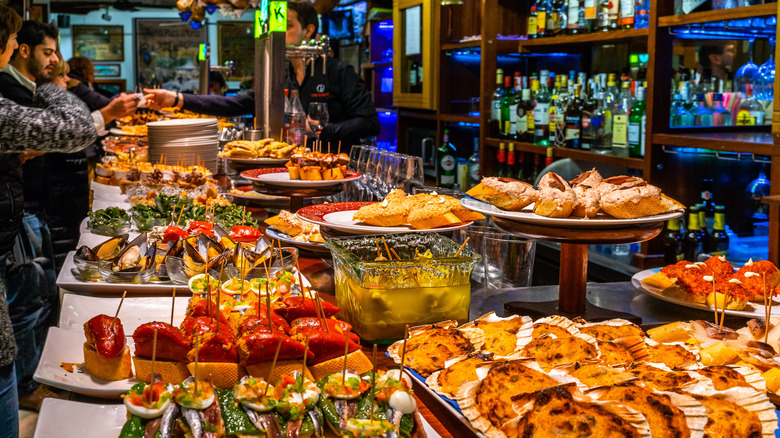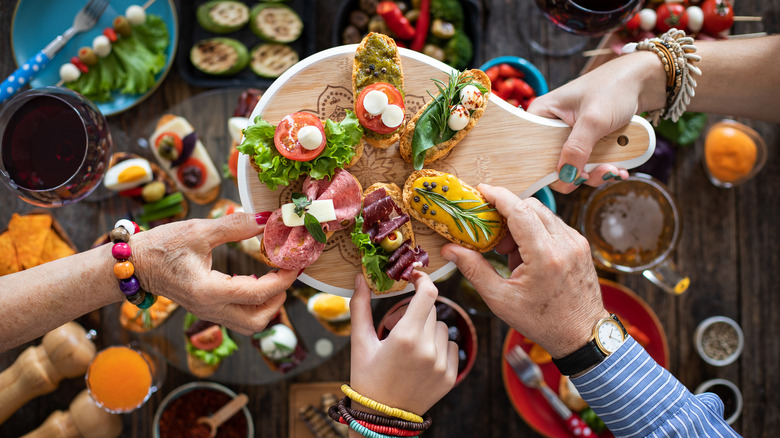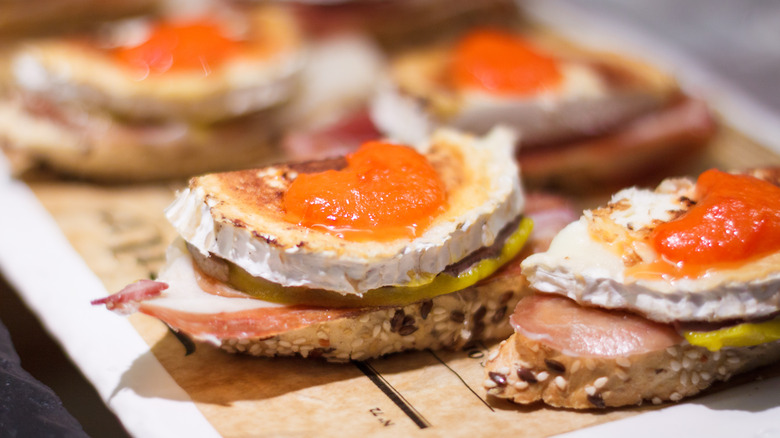Tapas Vs. Pintxos: What's The Difference?
We all have that friend who drives us nuts by nibbling on a bite or two of our food, after making a big show out of not ordering anything for themselves because they "aren't very hungry." Just like they "didn't have the last bit of milk and put an empty carton back in the fridge."
No? Doesn't sound familiar? Well, for those of you who do have a monster like this in your life (and if you don't, there is a good chance that you are that monster), it might behoove you to order a few tapas and pintxos for the table.
Native to Spain, both tapas and pintxos are terms to describe small plates of food, but tapas are often smaller versions of a large dish (and therefore, perfect for sharing with monsters), while pintxos are little enough to be gobbled in a single bite and often served on a toothpick or small piece of bread. What else differentiates the two dishes? Let's get into it.
What are tapas and pintxos?
"Strictly speaking," Pura Aventura points out, "[tapas] can be any kind of food as long as it comes out of the kitchen of a bar on a small plate." In Spain, tapas have traditionally been served as a complimentary accompaniment to the glass of wine you might have ordered. This is still common practice, so if you receive a plate of olives or some manchego cheese that you didn't ask for when your server delivers your drink, just act cool.
Unfortunately, as tapas plates got more complicated (and tourists got a little too excited about all the free food and began to take advantage), more and more bars in Spain began to charge for their tapas. In America, it would not be uncommon to see tapas or pintxos on the menu of your local Mediterranean bar or European bistro. While the U.S., sadly, does not generally replicate the "free-with-your-drink" custom, ordering these dishes by the twos and threes could make for some excellent snacking.
Order them alongside a bottle of wine to share with your pals, and you'll be keeping up with Spanish tradition. Just remember that both tapas and pintxos are intended as nibbles, so if you're feeling famished and order a tapa — unless you are a teacup pig or a small rodent of some sort — don't expect to be satiated for the evening.
Where do tapas and pintxos come from?
Pintxos come from a small, autonomous region of Spain known as the Basque Country. Though situated in the heart of Northern Spain, the Basque people have their own government, industry, and language, which is where the word "pintxo" comes from (via Encyclopedia Britannica).
Pintxo is Basque for "spike," according to Encyclopedia Britannica; so-named for the fact that these bite-sized nibbles are usually pinned to a slice of bread with a toothpick or skewer. Made to be enjoyed by an individual, Pura Aventura points out that "the art of eating pintxos – el txikiteo – is pretty much ... moving from one bar to another, eating a little, drinking a little, talking a lot."
To eat tapas — an activity that the Spanish refer to as "tapear" — is pretty much the same concept. In Spain, it is not uncommon to hop from bar to bar all evening long, munching on tapas (or pintxos) while you sip on a glass of Rioja or Cava. Traditionally, Spaniards do not eat dinner until late (think: 9 p.m. or so) and the tapas ensure that no one in your party turns into a hangry monster as outlined above.
While tapas have multiple origin stories (like the one about a king who, after a nasty stomach flu, decreed that no alcohol should ever be served without a bite of food alongside it), many agree that the practice of covering one's drink with a "tapa" (Spanish for cover) to keep the flies away is just smart, ¿no?
What are some common tapas and pintxos?
Ordering tapas in America means getting a little taste of the culinary culture Spaniards are so (rightfully) proud of. Things like patatas bravas (spicy potatoes), a Spanish omelette, or even a small plate of paella would be typical tapas, indicative of the Spanish staples. But tapas are open to interpretation and — especially in Spain — highly regionalized to reflect local culture. A tapas crawl in Galicia might yield empanadas and fresh, boiled octopus, whereas trips farther South will bring you Mediterranean-style favorites, like mussels, anchovies, and salad with salted cod (via Madrid Food Tour).
Pintxos are slightly tougher to pin down, if you'll pardon the pun. While tapas are usually small versions of a bigger dish (like paella) and made for sharing, pintxos are a one-bite wonder; and with such tiny real estate to work with, chefs have had to get creative to make a memorable pintxos experience. Basco Fine Foods has a list of some Basque favorites, like bacalao (salted cod), rabas (fried squid), and a Gilda pintxo, which is a mini-stack of olives, anchovies, and pickled peppers. Pintxos can be as simple as a piece of jamón serrano or manchego cheese on a slice of bread, or as complicated as slow-cooked crab tartlets flambéd with Cognac.
But whatever pintxos you order, make sure to let your tablemates know on the front end: These little guys are not for sharing.



